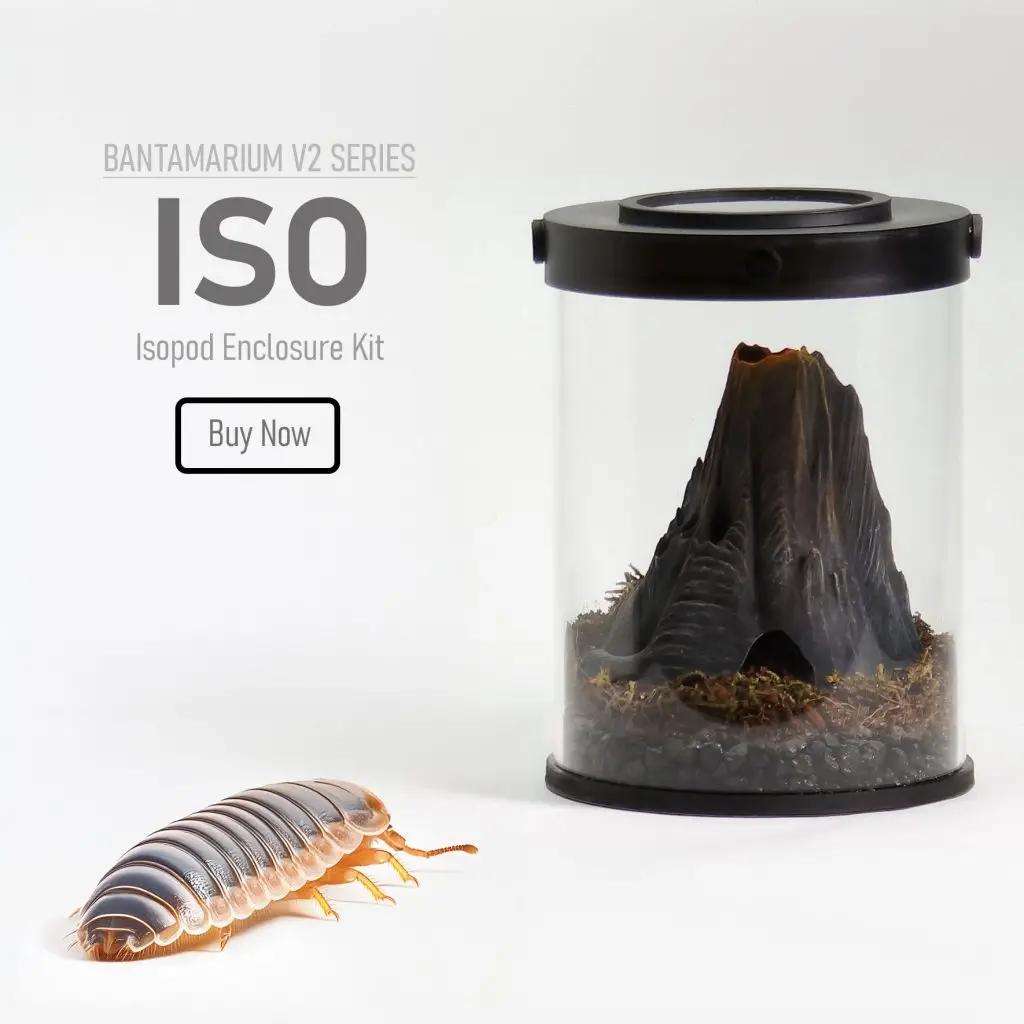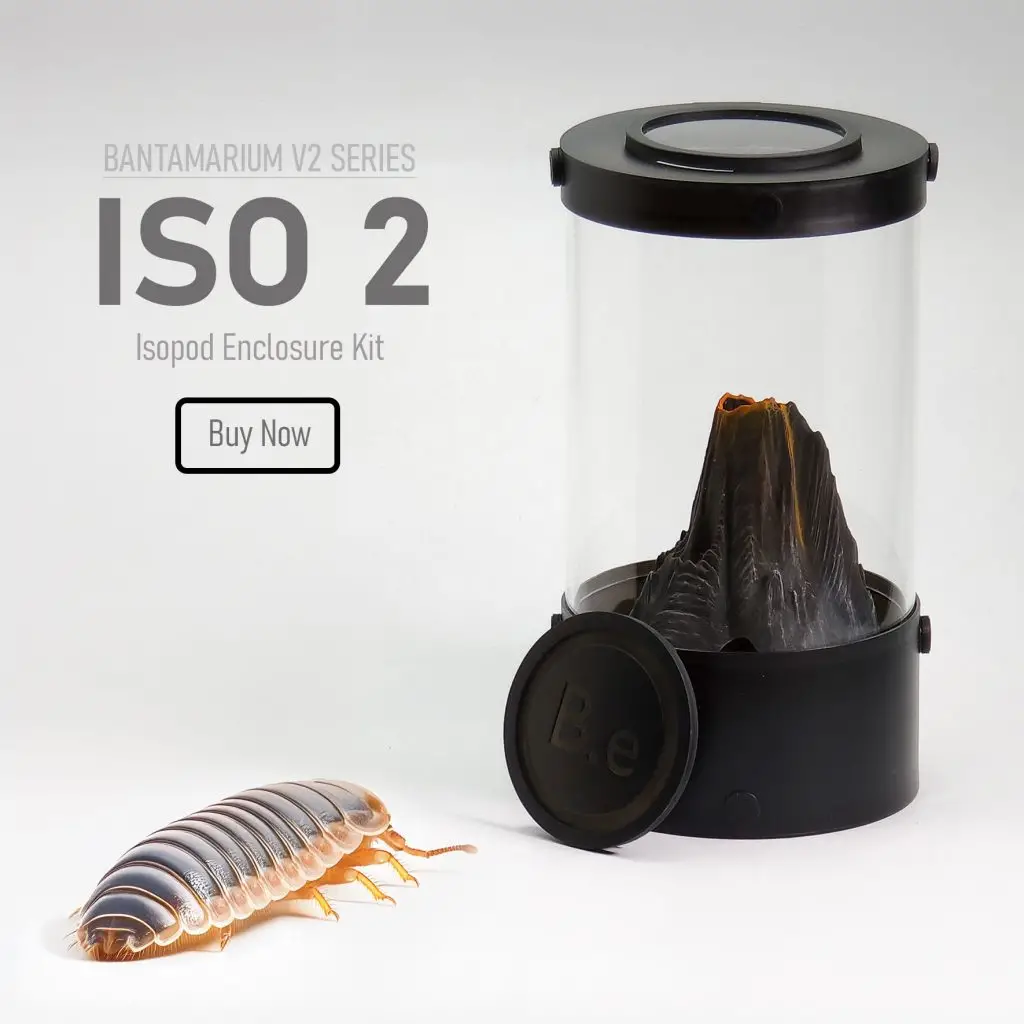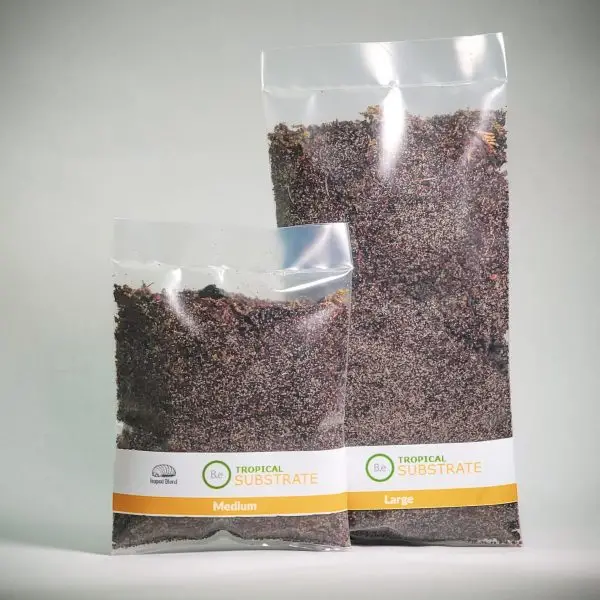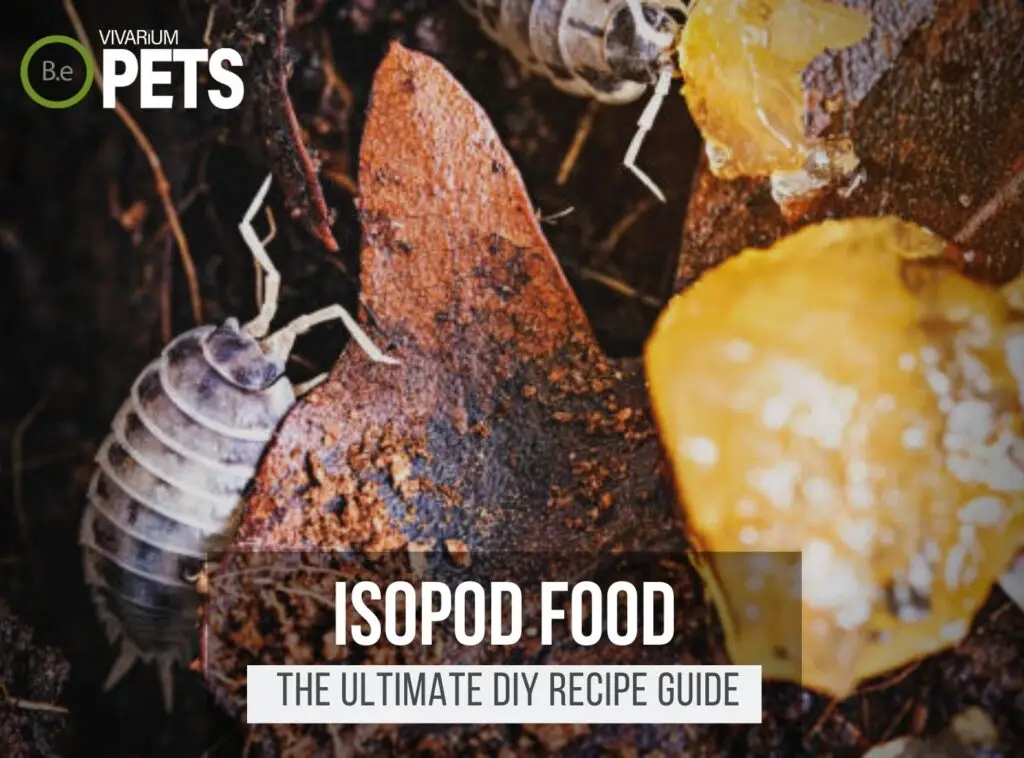Are you looking to adopt a Common Rough Woodlouse (Porcellio scaber) as a pet?
Maybe you have a neat idea for a postmodern Europe-themed terrarium using our Mini Europe Landmarks Decor Set. After all, these guys are native to that sector of the world.
In this guide, we’ll provide an overview of what they are and how they typically behave.
We will discuss the best ways to set up their habitat, provide food and water to your Porcellio scaber, and keep them safe and healthy. Let’s get started!
Table Of Contents:
ToggleWhat Are Common Rough Woodlouse?
The Common Rough Woodlouse, also known by its scientific name Porcellio scaber, belongs to the family of Porcellionidae.
This type of sow bug is a species of crustacean found in habitats all over Europe and is usually considered a pest when found inhabiting gardens.
The name “Rough Woodlouse” comes from its rough, bumpy, armor-like exterior. This helps to insulate the Woodlouse and protect it from the elements and predators.
Create an ideal habitat for your Common Rough Woodlouse with our Customizable Isopod Terrarium Kits, which include everything you need to get started.
What Does Common Rough Woodlouse Look Like?
The Common Rough Woodlouse adult is about 1.8 centimeters in length, with a soft and cylindrical body that is covered with hard, overlapping plates known as tergites.
It is usually yellow to brown and features a pair of long antennae on its head. Porcellio scaber also has seven pairs of jointed legs.
The last set of legs acts as a “tail” and is used for balance when the creature is walking. Its head and legs are made up of several segments for increased flexibility.
As its name suggests, its body has a very rough texture that is composed of raised oval shapes, with its edges slightly jagged.
Benefits Of Using Common Rough Woodlouse
The Common Rough Woodlouse is a beneficial species for bioactive terrariums.
It plays an integral role in the cycle of decomposition, recycling organic material such as fallen leaves and waste, thereby contributing to the overall health of the vivarium’s environment.
Common Rough Woodlouse are low-maintenance, hardy, and relatively inexpensive to provide for – making them a great addition to many vivarium systems.
In addition to their decomposer benefits, the Common Rough Woodlouse is also considered aesthetically pleasing for many viewers.
Common Rough Woodlouse species are considered escape-proof, meaning they cannot climb smooth surfaces, making it a safe option for enclosures with other animals such as reptiles and amphibians.
Many species of reptiles and amphibians enjoy consuming woodlice, which further emphasizes the important relationship between woodlice and other animals in the vivarium.
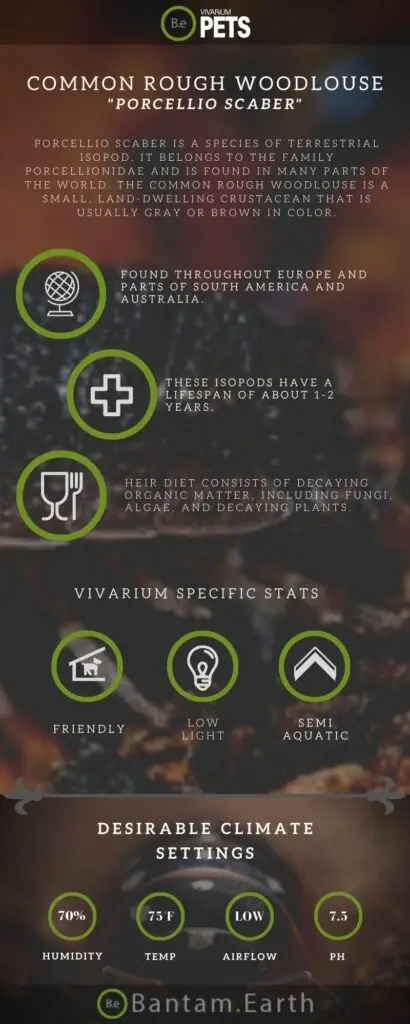

Common Rough Woodlouse Facts
Porcellio scaber is generally easy to take care of and has a peaceful temperament, with a lifespan of around two years and the potential of breeding in captivity.
They are active mostly at night and are sensitive to light and heat. During the day, they hide and remain inactive, returning to the surface at night to feed and look for mates.
Habitat
The Common Rough Woodlouse is found throughout Europe and parts of South America and Australia.
They live in a variety of habitats, from damp wooded areas to temperate grasslands, preferring environments that are not too dry or wet.
These woodlice live in shallow burrows of damp soil or leaf litter, usually found under rocks and logs, or in dark corners of gardens, where there is ample food and moisture.
Commonly found in agroforestry sites and residential gardens, Common Rough Woodlice can also be found in agricultural landscapes, such as fields and pastures.
Replicate their natural habitat perfectly with our Bioactive Isopod Substrate Blend, designed to provide the ideal moisture and organic content for your isopods.
Diet
In the wild, Porcellio scaber can be found among forest litter, mulch, and moss.
They feed by using two sets of antennae to detect and scavenge for their preferred foods such as decaying organic matter, fungi, and even vegetation.
Common Rough woodlouse also eat dead insects and other decaying invertebrates.
These isopods typically look for food that is accessible and easy to break down, such as soft fruits, mushrooms, and other rot-prone items.
Temperament
The Common Rough Woodlouse is known for having a gentle, shy temperament around humans and other animals.
While they can become stressed or frightened when they’re handled by human hands, they typically act with no aggression towards anyone.
They are relatively easy to handle as long as you take the time to ensure that your woodlouse is comfortable with the environment.
Porcellio scaber tends to flee from strange or loud noises, drastic changes in temperature, or unfamiliar objects.
With enough time, they can learn to view the presence of humans and other animals as a normal part of their environment.
Lifespan
The Common Rough Woodlouse can live for around 1-2 years and have a fairly simple life cycle.
After mating, female Common Rough Woodlice will produce up to 20 baby woodlice, known as nymphs, through parthenogenesis.
The nymphs grow in size and go through several stages of life before reaching adulthood.
During their lifespan, Common Rough Woodlice will molt up to seven times and, after each molt, will become larger.
Once adults, the woodlice undergo sexual maturity and begin the process of mating to reproduce.
Breeding
During mating, the male Porcellio scaber will connect to the female through his openings called gonopore, which are located on the underside of the woodlouse.
The female woodlouse will then use her genital opening to receive the sperm.
Fertilization takes place inside the female woodlouse’s body, and when the babies are ready to emerge, they will come out head-first from the female’s genital opening.
They will look out for food and care for themselves on their own once they are born.
Where To Find Common Rough Woodlouse
Common Rough woodlouses are nocturnal and can often be found under rocks, foliage, logs, and other places in which they can hide.
They have a wide range of distribution, ranging from the Americas to Central Europe and even further south in many regions of Africa.
Common Rough Woodlouse can also be purchased from pet stores, online pet retailers, and herp societies.
They are sold in different sizes and can be purchased as a single specimen or in a small group.
When purchasing Common Rough Woodlouse for sale, always look for healthy specimens that appear to be active and in good condition.
Common Rough Woodlouse Care
Common Rough Woodlice requires a humid environment with a balanced terrarium substrate.
They also need a wide variety of fruits and vegetables, as well as protein sources.
Proper handling is important and includes washing your hands before and after you touch the woodlouse.
Tank Requirements
The ideal tank requirements for Common Rough Woodlouse require a vivarium type with plenty of ventilation and airflow, as well as somewhere to retreat to during the day.
The best pH level is between 6.5 and 7, the ideal hardness level is at 7 – 8 dGH, and the Temperature is between 63°F and 77°F.
The substrate should be moist and consist of a mixture of materials such as coco fiber soil, fir bark, vermiculite, and even leaf litter.
While these woodlice do not require direct lighting, it should be taken into account, as the light levels in their natural environment change throughout the day.
Providing a timed terrarium light will help ensure their well-being.
What Does Common Rough Woodlouse Eat?
Common Rough Woodlice are primarily herbivores, meaning their diet mainly consists of plant material.
There are, however, a few things that you should provide them with to make sure they get all of the nutrients they need.
To sufficiently feed your Common Rough Woodlice (Porcellio scaber), you should provide them with a variety of foods, including:
- Fruits and vegetables (such as apples, carrots, and lettuce)
- Leaves and bark
- Leaf litter and other decaying plant material
- Live plants such as mosses and flowering plants
- Seeds and grains (such as rolled oats)
- Insects and other invertebrates
- High-quality commercial woodlouse feed
It’s important to feed your woodlice a balanced diet with plenty of fresh food and nutrients to keep them healthy. Feeding them too much of one food item can lead to nutritional deficiencies, so try to provide them with a variety of options.
If you’re more of an avid hobbyist like myself, be sure to check out my ultimate DIY Isopod food guide. I give a more in-depth explanation of the best foods and my favorite recipe.
Best Tankmates For Common Rough Woodlouse
When it comes to tankmates, the best choice for Common Rough Woodlice is other invertebrates such as snails, springtails, and millipedes.
These creatures share similar qualities such as the need for high humidity, slow and timid behavior, and a need for soil, wood, or leaf litter for food and shelter.
While the presence of these tankmates can increase the safety and complexity of the habitat, it is important to note that in some cases, the tankmates may compete with Porcellios scaber for their food.
Other species of isopods, like Cubaris or Armadillidium, are also compatible tankmates for Common Rough Woodlice.
These animals mainly prefer to feed on decaying organic matter, such as leaves and dead animals and are not a major threat to the safety of the Porcellio scaber.
Conclusion
In this article, we have discussed the basic requirements for proper care of the Common Rough Woodlouse.
We have provided an overview of the natural behavior and nutritional needs of the woodlouse and advised on proper housing and substrate.
Through these steps, you are sure to keep your Porcellio scaber healthy, happy, and well.
Create the ideal habitat for your isopods with our species-specific soil mixes and Insect Enclosure Kits. These products provide everything you need for a successful and thriving isopod colony.
Frequently Asked Questions
Porcellio scaber is a species of terrestrial isopod crustaceans that can be identified by their size, color, segmented body with overlapping plates, two pairs of antennae, uropods, and nocturnal behavior.
No, Porcellio scaber is not an insect. It is a species of crustacean, which is a group of arthropods that includes animals such as crabs, lobsters, and shrimp. Insects, on the other hand, are a different class of arthropods that have three body segments, six legs, and usually two pairs of wings.
Porcellio scaber is primarily nocturnal and becomes more active at night. During the day, they tend to hide in dark, damp places, such as under rocks, logs, or in soil. When disturbed, they can move quickly, but they are not particularly active or fast-moving animals compared to some other insects or arthropods.
Woodlouse are attracted to damp and humid environments and can enter homes through small gaps and cracks. .

